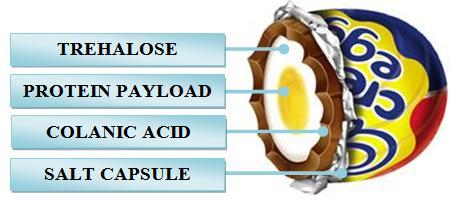Team:Imperial College London/M2
From 2009.igem.org

Contents |
Overview
WHAT
Module 2 is a distinct stage involving the production of an extracellular protective polysaccharide (colanic acid), acid resistance proteins, and storage metabolites (trehalose). Module 2 activties prime the E.ncapsulator against the rigours of both biotic and abiotic pressures.
WHEN
Module 2 is initiated following the completion of protein production (Module 1) and prior to genomic neutralisation (Module 3). It should be noted that Module 1 protein production continues at a lower 'maintenance level' throughout Module 2.
WHY
Abiotic resistance faciliates product storage. To achieve this, the disaccharide trehalose is produced to help maintain structural integrety during the freeze drying process. Trehalose additionally, maintains the internal 'protein payload' in its correct three dimensional conformation that would otherwise be disrupted by free radical attack and dessication.
Biotic resistance faciliates delivery passed the digestive assalts of the buccal cavity and acid-filled stomach. The exopolysaccharide colanic acid coating and various resistance proteins protect the E.ncapsulator against these harsh conditions. Once in the intestine, gut microflora strip away the E.ncapsulator's colanic acid coat paving the way for 'payload release'.
HOW
Through the course of evolution, E.coli have equipped themselves with a multitude of defences to enable colanisation of the intestine. We are using two global transcription factors (RcsB & YgiV) to hijack this natural process in a way that maximises acid resitance with avirulence. We have additionally upregulated a third enzyme (rfal) to re-direct exopolysaccharide polysaccharide production to enhance the encapsulation of single cells (over and above colony encapsulation). This step further reduces virulence while enchancing pill functionality.
Finally, the two biosynthetic genes (OtsA & OtsB) code for the production of trehalose.
Module 2 Part i: Encapsulation
In order to deliver our protein of interest to the gut, we must find some way of conferring our cells with some ability to withstand the harsh conditions present within the stomach.
Escheria coli naturally has a mechanism for withstanding these conditions, allowing them to survive through to the gut. This mechanism consists of secretion of a 'slime capsule,' which allows the cells to resist the highly acidic environment of the stomach. This 'slime capsule' mainly consists of secreted exopolysaccharides, such as colanic acid. By upregulating these genes that are naturally present, this will give our cells the ability to 'auto-encapsulate' - to secrete this slime capsule when required, and allowing our cells to bypass the stomach.
There are several genes required for synthesis of colanic acid.
RcsB, WaaL, B3023
This image shows a cross section of our cells, consisting of our protein of interest within, surrounded by ...
RcsB
RcsB upregulates the following genes:
ivy (Inhibitor of Vertebrate lysozyme)
- Discovered in 2001 as the first bacterial lysozyme inhibitor. This Type-C lysozyme inhibitor resides in the periplasm.1
MilC (Membrane-bound lysozyme inhibitor of Type C lysozyme)
- This is a lipoprotein that resides in the membrane. 1
References
- [http://www.ncbi.nlm.nih.gov/pubmed/19136591 The Rcs two-component system regulates expression of lysozyme inhibitors and is induced by exposure to lysozyme]
RcsB downregulates the following genes:
Module 2 Part ii: Trehalose Production
An important consideration when designing the specifications of the E.ncapsulator was the ability to store the cells for extended periods of time. This could be achieved by dehydrating the cells. However, normally under such conditions there poses a problem to maintaining the integrity of the proteins within the cells. This is problematic for us, as this could lead to breakdown of our protein of interest.
In order to preserve the integrity of our protein of interest during storage of the E.ncapsulator, we decided to incorporate a device for trehalose production within our system. Trehalose is a disaccharide formed from two glucose molecules. Throughout nature, trehalose is associated with resistance to dessication and cold shock, and is naturally produced in Escherichia Coli. We hope that by upregulating the trehalose production pathways in E.coli we can increase trehalose concentrations within our cell, thereby conferring some resistance to protein degredation in our system. This would allow easy transport and storage of the final product.
The trehalose coding region in E.coli consists of 2 genes, OtsA and OtsB - each coding for a different enzyme required for the conversion of glucose to trehalose.
 "
"




